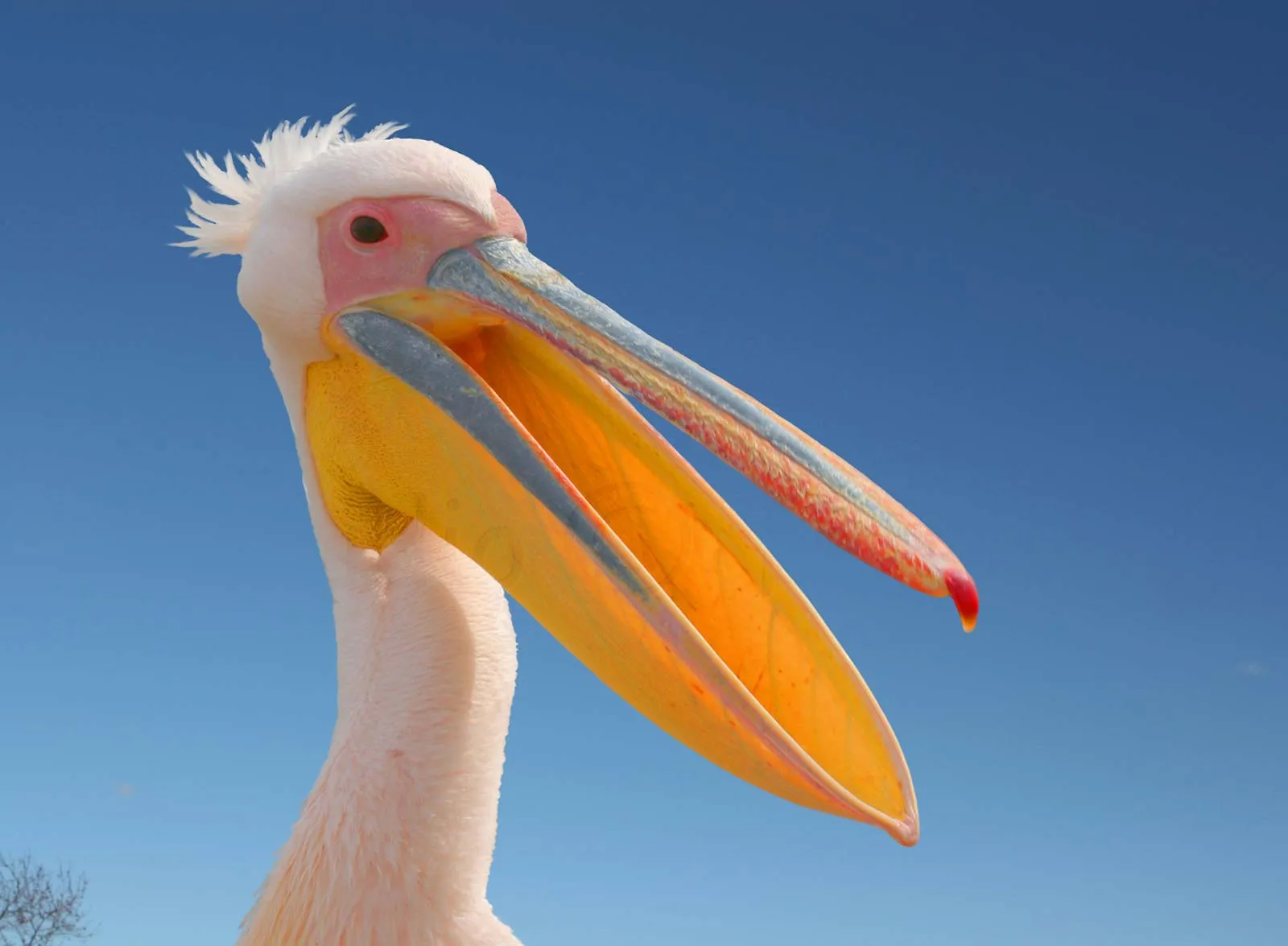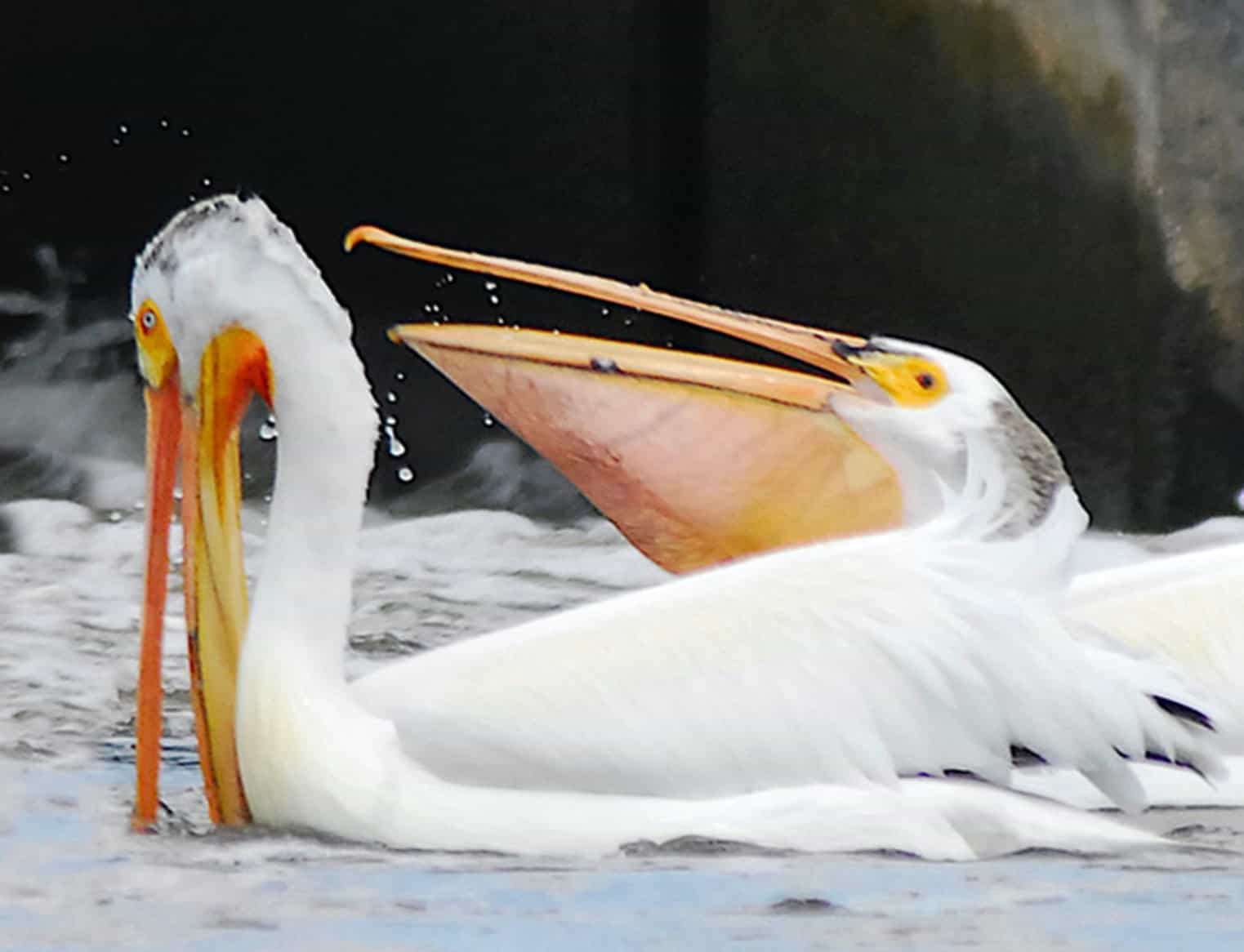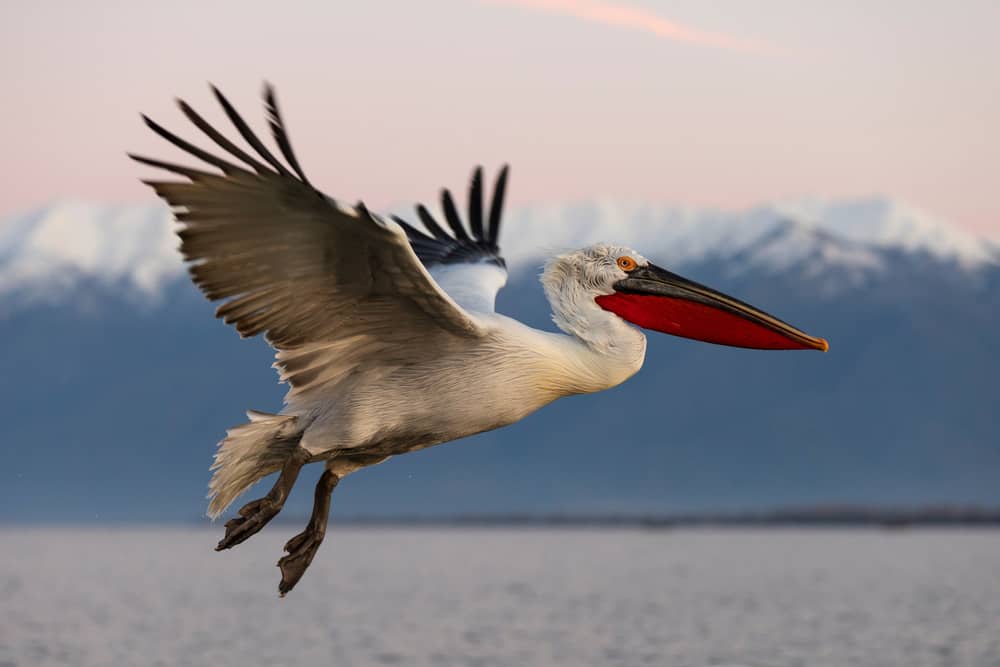Pelicans are fascinating large water birds that are easily recognized by the pouch under the beak. We often think of them as fish eaters, but the truth is that the pelican has a more varied diet than just fish. So what do pelicans eat?
In this article, we answer that question and learn more about pelicans, where they live, what they look like (other than having a large pouch), and if pelicans have any predators. We will also answer the question if a pelican can hurt a human.
Facts about Pelicans

Habitat
Pelicans belong to the bird family called Pelecanidae, and fossil records show that they have been around for over 40 million years. There are eight species of the modern pelican and they are found on all continents except Antarctica. However, they prefer the warmer regions of the globe.
Often pelicans are associated with the sea, but they live both in inland and coastal waters. As well as Antarctica, pelicans do not live in the Arctic, isolated ocean islands, or inland South America.
Where do the different pelican species live?
North America and Mexico are home to the American white pelican. The brown pelican lives in North America, northern parts of South America, the Caribbean, and the Galapagos. The Peruvian pelican can be found in Central and South America.
Australia has its own pelican species called the Australian pelican and the great white pelicans range from the eastern Mediterranean to South Africa. You can also find the great white pelicans in New Guinea, New Zealand, and some of the surrounding islands.
Pink-backed pelicans live in Africa and Arabia and used to be found in Madagascar as well. The spot-billed and Dalmatian pelicans are native to Asia.
Appearance
Other than the large pouched bills, what are the features of pelicans? Pelicans are large birds, but there are differences between the species. The smallest pelican is the brown pelican which weighs around 3 kg and has a wingspan of approximately 1.85 cm.
The largest in the species is the Dalmatian pelican. It can weigh as much as 15 kg and has a maximum wingspan of nearly 3.5 m. The Australian pelican has the longest bill for any bird.
Pelicans have long necks that match their long bills. The flexible skin pouch under the beak is known as a gular pouch and allows them to capture multiple fish at once.
Most pelicans have white or cream-colored feathers with black or brown accents. The Peruvian and brown pelicans have brown feathers. They have short, webbed feet that make them good swimmers.
Reproduction
Pelicans are seasonally monogamous, meaning that at the start of the breeding season they pair up and stay together for the rest of the season. When the next breeding season arrives, they might find a different mate.
The incubation period of pelican eggs is between 32 and 35 days. When the chicks hatch, they are featherless and their eyes are closed. In nests with multiple eggs, it is common that the chicks will compete and only one will survive.
When the chicks are old enough to leave the nest, they join a creche, which are groups of up to a hundred chicks. They remain in the creche until they can fly, usually about two months old. The parents will stop feeding around four months after hatching.
What do pelicans eat?

The pelican’s diet is mainly fish, but they are not the only things pelicans eat. We will look at other things on a pelican’s menu in a moment, but first, we will focus on their main food source.
The type of fish a pelican will eat depends on its habitat and its size. Smaller pelicans will eat fish up to a few inches long, while larger pelicans such as the Dalmatian pelican can eat fish that are a few feet long.
Examples of the types of fish pelicans will eat include herring, sheepshead, minnows, mullet, and silversides. The Pacific coast pelicans will often eat a lot of anchovies and sardines.
What else do pelicans eat except fish?
Pelicans are known to eat amphibians such as frogs and salamanders and crustaceans such as shrimp and crayfish. They will also eat turtles, insects, and even other birds.
In fact, birds are a large food source for many pelicans. For example, Australian, brown and Peruvian pelicans regularly eat young birds and the great white pelicans living in London parks have been spotted eating pigeons.
What do baby pelicans eat?
Baby pelicans depend on their parents until they are developed and strong enough to catch their food. They will eat regurgitated fish from the parents’ bills, which act as a mini pool, and the young hunt for their food from inside the bill. Here is a video of a pelican feeding its young.
You can find more in-depth information on the pelican’s diet here.
How do pelicans hunt?
Pelicans can hunt alone or in groups. White pelicans are known to often fish in groups when they will form a line to chase schools of fish into shallow water where they will scoop them up.
When pelicans hunt for larger fish, they catch them with the bill-tip. They then toss the fish in the air and catch it and slide it into the pouch head first. When they catch fish scooping it into the pouch, they need to drain the water before they can swallow the fish. This usually takes about a minute.
The North American brown pelicans catch their prey plunge-diving. Other species known to do it occasionally are the Peruvian and Australian pelicans. Here is a video of a pelican diving at 40 miles per hour to catch a fish.
You can find out more about the group and solitary feeding habits of pelicans here.
Can a pelican hurt a human?
Pelicans generally don’t hurt people. For starters, though there have been some instances reported where hungry pelicans have tried to fit a part of a human into their beak, they do not attack people.
Pelicans’ beaks are designed to scoop and not bite, and therefore they have very little biting power. Therefore, you would be unlikely to get anything more than a scratch even if a pelican tried to grab you.
However, sometimes a pelican has inadvertently hurt a human. For example, a woman had to have stitches on her face when a pelican collided with her in the middle of its dive. It was worse for the pelican, though, as it died because of its miscalculated dive.
What predators eat pelicans?
The biggest threat to pelicans at sea are sharks and sea lions, which can catch them while they are attempting to catch a fish. A lone pelican is more at risk, which is why certain pelican species prefer to hunt in groups.
On land, pelicans are most at risk before the eggs have hatched. Many predators will eat pelican eggs, including small reptiles, alligators, dogs, cats, and raccoons.
Facts and Extreme pelican behavior
- Pelicans can hold up to three gallons of water in their pouch.
- The bones of pelicans have air sacs that allow them to fly easily and reach heights of 10,000 feet.
- According to a myth, pelicans would stab themselves in the breast to feed their chicks.
- A pelican in Switzerland’s largest zoo, the Zoo Basel, has been nicknamed killer Jonny because it hunts and eats any smaller bird that enters the pelicans’ enclosure. Since Jonny started attacking other birds, there are hardly any other birds on the pelican enclosure’s lake.
- Pelicans can stay cool by taking water into their pouches and shaking it. This motion helps the moisture to evaporate and provides a cooling action.
- Pelicans are sociable birds and prefer to live in larger groups. The groups of breeding pelicans are known as colonies.
- Both parents take part in creating a home for their young and they build nests in the trees or sometimes on the ground. The eggs hatch after about a month and both parents will hunt and regurgitate food for the chicks.
- Pelicans are not on the menu for most people. However, people sometimes eat pelicans in Kenya, East Africa. Pelican meat is said to be very salty, probably from all the fish and seawater they digest.
- Some pelicans are endangered, including the Dalmatian pelican, which is on the International Union for Conservation of Nature’s list of endangered species. Their numbers are closely monitored.
- Plastic pollution poses a risk for many pelicans and their chicks. As the pelican scoops up fish into its pouch, it can scoop up plastic rubbish, too. This plastic can damage both the adult pelicans and their chicks when they eat the regurgitated plastic.
- Pelicans cannot sing. However, they will squawk and grunt.
Conclusion
Even though you now know what pelicans eat, it is not advised to feed pelicans. Especially pelicans who are still feeding their young as the chicks will eat anything that the parent regurgitates for them.
We hope that you now have a good understanding of what pelicans eat. If you have other questions about the pelicans’ diet or pelicans in general, you can write them in the comments section.
